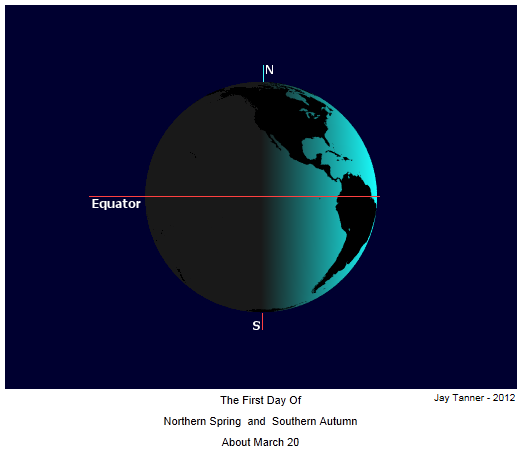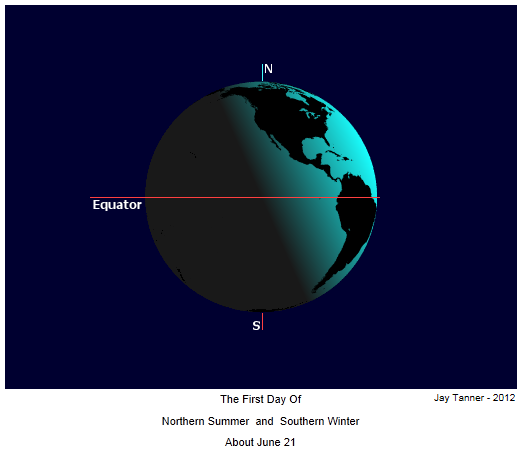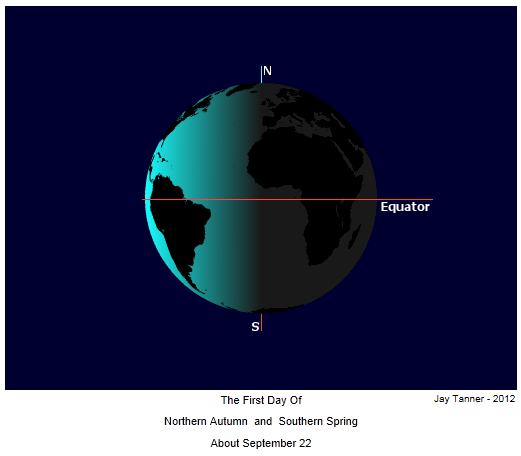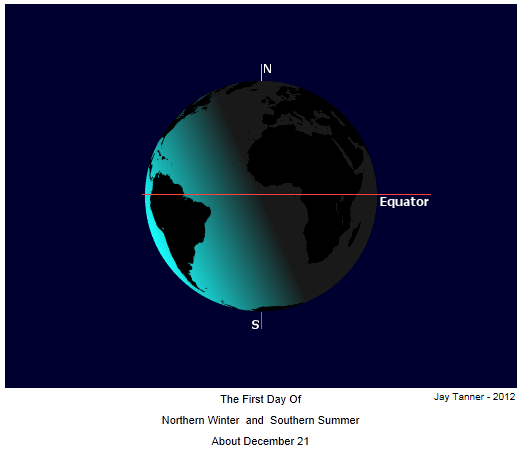For Any Gregorian Year From 1600 to 2200 and Local Time Zone
PHP Program by Jay Tanner
Based on the NASA/JPL DE405 Ephemeris Model and the NASA Polynomials For Delta T
Dates and Local Standard Times of the Equinoxes and Solstices For Year 2024
Local Time Zone Offset UT-05:00
============================================================================
Event Julian Date TT Date Time DoW Time Scale
================= ================ =========== ===== === ============
March Equinox 2460389.62997189 2024-Mar-20 03:07 Wed TT
2024-Mar-19 22:06 Tue Loc Std Time
June Solstice 2460482.36952937 2024-Jun-20 20:52 Thu TT
2024-Jun-20 15:51 Thu Loc Std Time
September Equinox 2460576.03148109 2024-Sep-22 12:45 Sun TT
2024-Sep-22 07:44 Sun Loc Std Time
December Solstice 2460665.89006706 2024-Dec-21 09:22 Sat TT
2024-Dec-21 04:20 Sat Loc Std Time
============================================================================
NOTE:
To adjust for daylight saving/summer time, add 1 hour to the local standard
times, being careful to watch for a possible change of date while doing so.
Definitions of the Solstices and Equinoxes Used Here
The dates and times of the Northern/Southern solstices and equinoxes
are computed according to the following definitions:
are computed according to the following definitions:
The solstices refer to that point in the sky where the sun appears to reach its highest or lowest midday elevation in the sky and where it appears to hover for a day or so before slowing starting to move back in the opposite direction, southward or northward, depending on the season, a little more each day. There are two such solstices each year and they mark the dates on which the summer and winter seasons begin.
The equinoxes refer to those dates of the year where the days and nights throughout the world are most closely equal in length (closer to 12h/12h) than on any other date of the year. There are two equinoxes each year marking the dates on which the spring and autumn seasons begin and the apparent geocentric sun crosses the celestial equator.
Although there are 2 equinoxes and 2 solstices each calendar year, there are actually 8 distinct seasons in each year. This is because during each calendar year, there are two distinct occurrences of each season at six-month intervals. The southern hemisphere experiences the same seasons as the northern hemisphere, but southern seasons are six months offset from the same northern seasons, hence distinct.
For example, when it is winter in New York City, USA, it is summer in Sydney, Australia and vice versa. Both places experience winter and summer during the same year, but those seasons are some 6 months apart and quite distinct from each other. The same applies equally to all the other seasons as well, so that each of the 4 seasons occurs 2 times during each calendar year, once in each hemisphere, half a year apart, for a total of 2×4 = 8 distinct seasons every year.
The equinoxes refer to those dates of the year where the days and nights throughout the world are most closely equal in length (closer to 12h/12h) than on any other date of the year. There are two equinoxes each year marking the dates on which the spring and autumn seasons begin and the apparent geocentric sun crosses the celestial equator.
THE 8 SEASONS OF THE YEAR
Although there are 2 equinoxes and 2 solstices each calendar year, there are actually 8 distinct seasons in each year. This is because during each calendar year, there are two distinct occurrences of each season at six-month intervals. The southern hemisphere experiences the same seasons as the northern hemisphere, but southern seasons are six months offset from the same northern seasons, hence distinct.
For example, when it is winter in New York City, USA, it is summer in Sydney, Australia and vice versa. Both places experience winter and summer during the same year, but those seasons are some 6 months apart and quite distinct from each other. The same applies equally to all the other seasons as well, so that each of the 4 seasons occurs 2 times during each calendar year, once in each hemisphere, half a year apart, for a total of 2×4 = 8 distinct seasons every year.
Let: Blue Seasons = Northern hemisphere and Red Seasons = Southern hemisphere
- Spring/Autumn - Equinox
Begins at the moment when the apparent geocentric sun reaches declination = 0°
Sun crosses geocentric celestial equator from south to north.
- Summer/Winter - Solstice
Begins at the moment when the apparent geocentric sun reaches RA = 06h (90°).
Sun appears stationary at its northernmost declination (approx.+23.45°),
before heading back south a little more each day.
- Autumn/Spring - Equinox
Begins at the moment when the apparent geocentric sun reaches declination = 0°
Sun crosses geocentric celestial equator from north to south.
- Winter/Summer - Solstice
Begins at the moment when the apparent geocentric sun reaches RA = 18h (270°).
Sun appears stationary at its southernmost declination (approx.-23.45°),
before heading back north a little more each day.